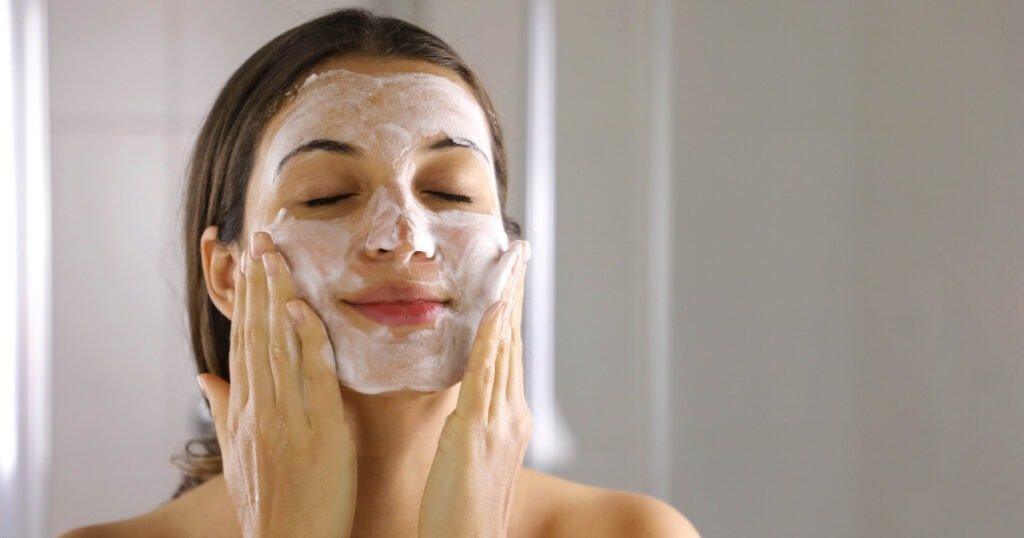Are you unsure what to use first—a face wash or a cleanser? If your skin is oily or a combination, knowing which product to start with can be challenging. The good news is that some simple rules help you choose the right variety of products for your skin type.

In this article, we’ll look at the differences is a face wash and a cleanser and how to choose the best combo for your needs. You’ll also learn why double cleansing could be beneficial and how to avoid over-cleansing.
Finally, we’ll explore oil-free formulas and when it’s time to consult with a dermatologist. So let’s get started!
Skin Type Matters
Finding skincare products that work best for oily and combination skin types can be difficult.
When starting a new skincare routine, the first step should be to use a face wash or cleanser. A face wash is typically more gentle than a facial cleanser and helps remove dirt, oil, makeup, and other impurities from the skin’s surface.
But, a facial cleanser is usually stronger and can help penetrate deeper into pores to help remove excess sebum and deep-seated dirt. Depending on your skin type—whether oily, combination, or normal—you may need to adjust your cleansing routine accordingly.
For oily or combination skin types, look for gentle foaming cleansers with salicylic or glycolic acid ingredients. These can help reduce excess oil production without stripping away moisture. If your skin is normal or dry skin, go for creamy formulas that do not contain harsh sulfates. These can strip away natural oils leaving your complexion dry and irritated.
Use a Cleanser First
You’re likely wondering which product to start with for your oily and combination skin–and the answer is a cleanser! Employing irony, you’ll want to begin with an end-point.
Cleansers are designed specifically for oily and combination skin types, as they help remove excess oil while hydrating the areas of dryness. They contain ingredients such as salicylic acid that work to rebalance the complexion by breaking down build-up on the skin’s surface without stripping away essential oils. Additionally, cleansers with glycolic or lactic acid can help reduce pores, wrinkles, and discoloration. Certain formulas also provide SPF protection from harmful UV rays.
After using a cleanser, following up with a face wash is important to remove any remaining dirt or debris left behind from cleansing. This will ensure your pores stay clean and free of any bacteria build-up that could lead to breakouts or other unwanted side effects.

Follow with a Face Wash
After cleansing your complexion, following up with a face wash is important. This will help in removing any remaining dirt that may have been left behind.
Face washes are typically formulated with mild detergents and surfactants like soap or synthetic emulsifiers. This help breaks down oil-based dirt and makeup on the skin. Using water helps rinse the dirt while also helping hydrate the skin.
Additionally, face washes may contain extra ingredients such as humectants and moisturizers that provide additional hydration. They usually contain fewer active ingredients than cleansers, making them perfect for people who prefer not to use harsher products such as toners or exfoliants.
When using a face wash, make sure to thoroughly rinse away all of the product so that no residue is left behind. This will help prevent clogged pores or over-drying of the skin caused by leftover cleansers or soap.
Double Cleansing is Key
Double cleansing is key for achieving a balanced complexion. Studies show that it can help reduce pores by up to 50 percent! So don’t be afraid to give your skin some extra TLC by using two cleansers.
Double cleansing is especially beneficial for combination skin types as it allows you to target different areas of the face with specific products. For example, oilier face areas can be treated with an oil-based cleanser, while drier areas need more hydration.
By doing a double cleanse, you’ll ensure that all makeup and dirt build-up from your day has been properly removed from your skin, which will help keep it looking fresh and glowing. Adding this step into your skincare routine will allow you to relax and unwind.

Avoid Over-Cleansing
Although double cleansing is beneficial for skin health, it’s important to take caution not to over-cleanse, as this might strip the skin of its natural oils.
When using a face wash or cleanser for oily and combination skin, it is best to stick with lukewarm water instead of hot water.
Finding a gentle cleanser free from harsh ingredients such as parabens, sulfates, and fragrances that can further irritate the skin is also important. Look for facial cleansing products that contain hyaluronic acid, which gently removes dirt and oil build-up.
Additionally, use a mild cleanser only once daily – twice at most if needed – to avoid irritating your complexion.
Ensure to follow up with moisturizers containing SPF protection that replenish the lost hydrating oils caused by washing your face with cleansers.
Look for Oil-Free Formulas
When selecting a facial cleanser, opting for oil-free formulas that won’t clog pores and exacerbate oily or combination skin types is important. This means avoiding cleansers with mineral oil, petrolatum, and other heavy oils, which can cause breakouts.
Instead, look for micellar water, a gentle cleansing solution of tiny micelles (oil molecules) suspended in soft water. Micellar water removes dirt and makeup without stripping the skin and hydrates while doing so.
Salicylic acid is an effective option for those with acne-prone skin as it helps unclog pores and prevent new ones from forming. Glycolic acid is another great choice for those looking to clear their skin of acne or signs of aging, as it helps to exfoliate.
Finally, benzoyl peroxide is a powerful antibacterial agent that can reduce the number of bacteria on the face’s surface, which can lead to breakouts.
No matter what type of facial cleanser you choose, ensure it’s free from oils and other pore-clogging ingredients if you have oily or combination skin!

Consult with a Dermatologist
If you’re having trouble finding the right facial cleanser, it’s time to seek expert advice and consult with a dermatologist. They can be like a lighthouse in the stormy sea of skincare, guiding you to the product that best suits your needs.
A dermatologist can help recommend options depending on whether you have sensitive or acne-pore skin. They may also suggest products that protect against environmental pollutants or provide gentle exfoliation for oily and combination skin types. Cleansing balms are particularly beneficial as they won’t strip away natural oils while still removing dirt, oil, and makeup.
Conclusion
If you have oily or combination skin, starting with a cleanser is important. This helps remove impurities and excess oil while preparing your skin for a face wash.
For best results, double-cleanse your skin every day. Make sure both products are oil-free and suitable for your skin type.
An interesting statistic is that up to 75% of people use the wrong skincare products for their skin type, leading to irritation and other issues.
To make sure you get the most from your skincare routine, consult a dermatologist who can recommend the right products!
